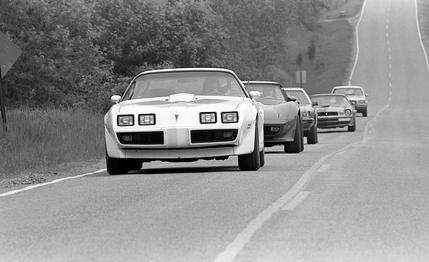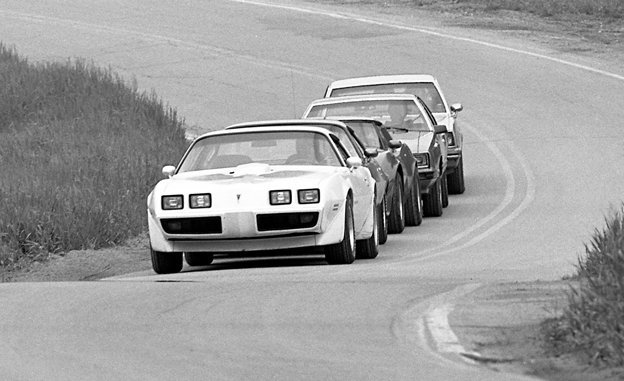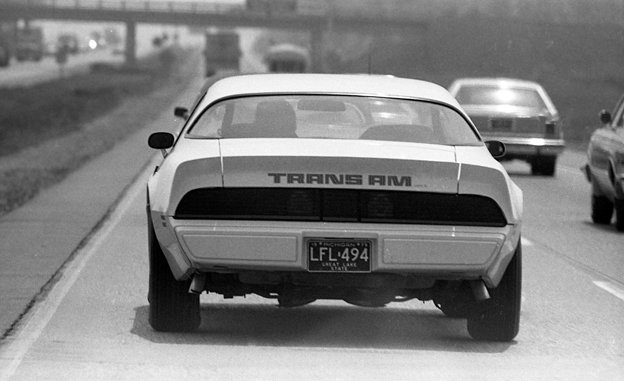 Archived Comparison
From the September 1979 issue
Archived Comparison
From the September 1979 issue
Now that the rubber dust has settled and five test cars have stopped smoking, the story can be told. We have a champion, a car we can confidently proclaim the best handler in all the land: the Pontiac Firebird Trans Am.
It's taken a two-week tournament to pick this winner, a contest so rigorous that casualties were incurred: one engine exploded in the heat of battle, two tires shredded themselves down to steel cord, and eighteen more Goodyears, Generals, and Michelins each sacrificed a 40,000-mile tread life to the cause. But the effort was a noble one. From this bunch of five automotive athletes, the Trans Am has risen cleanly and clearly superior.
We'd be nuts to blurt out such an opinion without conviction. Car handling being the bar-fight starter that it is, we've gone to more than the usual trouble to convince ourselves before we tried to convince you of anything here. So this is hardly a quickie car comparo. This is a $100,000 handling hoedown that names names, answers questions, and, we hope, sheds a few rays of sunshine on a shadowy side of our car experiences.
What we did was take $46,000 worth of new cars and push them mercilessly through a battery of tests to quantify each one's basic agility. To pin down the results, we rented $40,000 worth of highly sophisticated instrumentation and access to a multi-million-dollar proving grounds. This allowed a number of trials that are common in the automobile industry, but normally way beyond the scope of car magazines. Good test procedures and accurate measuring equipment would produce answers we could trust to questions we had never asked before, but we were just as confident that it would be impossible to ask all the pertinent handling questions in the sterile, scientific confines of a test track.
So we left Ohio's magnificent Transportation Research Center (TRC), fully intending to second-guess our objective findings with over-the-road evaluation, where the only instrumentation would be the seats of our pants. We rotated five editors through all the cars during five laps of a road circuit through Michigan woods. As you might expect, the result was two different rankings. But we never for a minute expected skidpad and transient-maneuver numbers to yield THE ANSWER. All they do is offer powerful clues to help our admittedly subjective bottom-line resolutions make the most sense.

So we'll tell you right now we've named the best-handling car (and positions two through five as well) by a staff poll and not by computer printout. The staff knew every tidbit of test results, drove every car over the same route on the same day, and only then sat down to rank the contenders. We trusted the instruments to supply us with a few critical pieces of information, but it was our real-world driving that filled in the gaps and cemented this puzzle together. Selecting the participants involved the usual blend of past prejudice and adventurous open-mindedness.
The Corvette owns America's only fully independent suspension, and we wanted it here even if Chevrolet had mixed emotions after our previous comments about this car. The Z28 also came somewhat grudgingly, with a few cop-outs like "We didn't really mean it to be that kind of car." Pontiac eagerly offered its best—a Trans Am with a small V-8 (302 cubic inches) and no A/C, both for optimum weight distribution.
The Capri had won rave reviews in our recent sport-coupe comparison, so we advanced it to this main event. And to probe the potential of the front-drive future that's just around the corner for most American cars, we wanted a representative from GM's new X-body line. We haven't lived with all the permutations of this car yet, but early proving-ground drives had left us most favorably impressed with the Pontiac Phoenix in SJ (handling package) trim.
Horsepower has a way of upstaging other, less dominant traits in this sort of comparison, so we did our best to factor it out of the picture. First, we matched the cars as equally as feasible. We picked the quickest Phoenix money can buy and the slowest Corvette. The Z28 was handicapped by an automatic transmission, and the Trans Am came armed with a measly 150 horsepower. This hardly produced what you'd call an even match, but we took pains to design handling tests where power-to-weight ratio wasn't a factor.
The test scheme involved five basic procedures. First we measured roadholding, or the cornering force each car could generate on four circles of 208, 534, 834, and 1160 feet in diameter. This simulates freeway-entrance-ramp . or traffic-circle turning (at the limit of tire adhesion), at roughly 35 mph, 55 mph, 70 mph, and 80 mph respectively.
Test two was a measure of maneuverability, driving through the usual eleven traffic cones spaced every 100 feet. But this time we added something: instrumentation to tell us exactly what was going on with lateral acceleration, yaw rate, roll angle (see glossary), and steering-wheel position. All this came from a very expensive ($26,500) inertial-guidance-system-in-a-box called "the Humphrey package," which fed a steady stream of vehicle-attitude signals to an oscillograph recorder. This latter piece of equipment provided continuous traces of exactly what each car did in each test run.

Test three was a simple steering-effort measurement, an attempt to quantify road feel. It's an indication of how much has been allowed to filter through each car's power-steering system. With a higher overall effort, the critical force variations between the tire and the road are easier to sense at the steering wheel. To take these readings, we used a Lebow strain-gauged steering wheel that clamped over the standard wheel.
Test four was probably the most revealing of them all, because it clearly defined differences in steering response among these five cars. It tells you how much cornering you get for a given turn of the steering wheel, a characteristic that was measured by slowly accelerating each car on the 208-foot circle, from 0 mph all the way up to each car's adhesion limit. An X-Y plotter graphed lateral acceleration (from the Humphrey package) versus steering-wheel angle (signaled by a potentiometer driven by the steering-wheel hub). A low, flat line that extends as far as possible to the right on this chart is best, because it indicates quicker steering, less under' steer, and a higher cornering limit.
The final test was the most complicated (and unfortunately the least revealing). It's called a "transient response to a step steer input" in the industry. What this means is how a car responds in the split seconds after the steering wheel is abruptly moved from straight ahead to some predetermined angle. The angle we chose was one that would yield 0.6-g cornering for all cars after the "transient" part of the response was over and the test car had stabilized into a smooth, steady arc. We used a link-chain hooked to the steering wheel to provide a solid (but adjustable) stop, and the
Humphrey package fed the oscillograph recorder to tell us exactly what was going on. We were most interested in response time, or how long it would take each car to switch from straight-ahead running to hard cornering. As it turned out, all these cars responded in a very similar fashion, with no significant difference in response times whatsoever. The instruments graded the Corvette champion of the proving grounds, so we'll discuss its report card first.
Even though we blew an engine proving it, nothing can touch the Corvette for pure cornering. It never dropped below 0.80 g on any of the skidpads, and it loved the bigger circles most of all, where there was less understeer to scrub off speed. A few laps like this will move every drop of blood in your body into your outboard ear, which is also typical of what happens to the engine's oil supply.